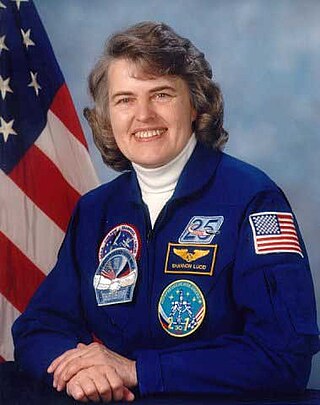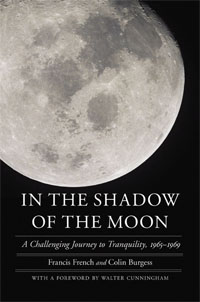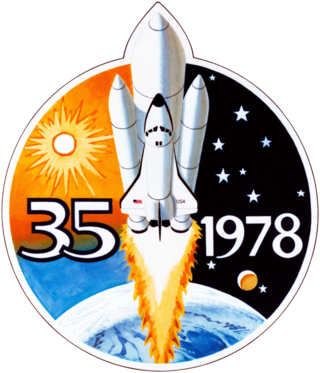Related Research Articles

An astronaut is a person trained, equipped, and deployed by a human spaceflight program to serve as a commander or crew member aboard a spacecraft. Although generally reserved for professional space travelers, the term is sometimes applied to anyone who travels into space, including scientists, politicians, journalists, and tourists.

Vladimir Mikhaylovich Komarov was a Soviet test pilot, aerospace engineer, and cosmonaut. In October 1964, he commanded Voskhod 1, the first spaceflight to carry more than one crew member. He became the first Soviet cosmonaut to fly in space twice when he was selected as the solo pilot of Soyuz 1, its first crewed test flight. A parachute failure caused his Soyuz capsule to crash into the ground after re-entry on 24 April 1967, making him the first human to die in a space flight.

The Space Race was a 20th-century competition between two Cold War rivals, the United States and the Soviet Union, to achieve superior spaceflight capability. It had its origins in the ballistic missile-based nuclear arms race between the two nations following World War II. The technological advantage demonstrated by spaceflight achievement was seen as necessary for national security, and became part of the symbolism and ideology of the time. The Space Race brought pioneering launches of artificial satellites, robotic space probes to the Moon, Venus, and Mars, and human spaceflight in low Earth orbit and ultimately to the Moon.

Charles Moss Duke Jr. is an American former astronaut, United States Air Force (USAF) officer and test pilot. As Lunar Module pilot of Apollo 16 in 1972, he became the 10th and youngest person to walk on the Moon, at age 36 years and 201 days.

Leroy Gordon "Gordo" Cooper Jr. was an American aerospace engineer, test pilot, United States Air Force pilot, and the youngest of the seven original astronauts in Project Mercury, the first human space program of the United States. Cooper learned to fly as a child, and after service in the United States Marine Corps during World War II, he was commissioned into the United States Air Force in 1949. After service as a fighter pilot, he qualified as a test pilot in 1956, and was selected as an astronaut in 1959.

The Vostok programme was a Soviet human spaceflight project to put the first Soviet citizens into low Earth orbit and return them safely. Competing with the United States Project Mercury, it succeeded in placing the first human into space, Yuri Gagarin, in a single orbit in Vostok 1 on April 12, 1961. The Vostok capsule was developed from the Zenit spy satellite project, and its launch vehicle was adapted from the existing R-7 Semyorka intercontinental ballistic missile (ICBM) design. The name "Vostok" was treated as classified information until Gagarin's flight was first publicly disclosed to the world press.

Shannon Wells Lucid is an American biochemist and retired NASA astronaut. She has flown in space five times, including a prolonged mission aboard the Russian space station Mir in 1996, and is the only American woman to have stayed on Mir. From 1996 to 2007, Lucid held the record for the longest duration spent in space by an American and by a woman. She was awarded the Congressional Space Medal of Honor in December 1996, making her the tenth person and the first woman to be accorded the honor.

The Mercury Seven were the group of seven astronauts selected to fly spacecraft for Project Mercury. They are also referred to as the Original Seven and Astronaut Group 1. Their names were publicly announced by NASA on April 9, 1959; these seven original American astronauts were Scott Carpenter, Gordon Cooper, John Glenn, Gus Grissom, Wally Schirra, Alan Shepard, and Deke Slayton. The Mercury Seven created a new profession in the United States, and established the image of the American astronaut for decades to come.

NASA Astronaut Group 2, also known as the Next Nine and the New Nine, was the second group of astronauts selected by the National Aeronautics and Space Administration (NASA). Their selection was announced on September 17, 1962. The group augmented the Mercury Seven. President John F. Kennedy had announced Project Apollo, on May 25, 1961, with the ambitious goal of putting a man on the Moon by the end of the decade, and more astronauts were required to fly the two-man Gemini spacecraft and three-man Apollo spacecraft then under development. The Mercury Seven had been selected to accomplish the simpler task of orbital flight, but the new challenges of space rendezvous and lunar landing led to the selection of candidates with advanced engineering degrees as well as test pilot experience.

NASA Astronaut Group 3—'The Fourteen'—was a group of fourteen astronauts selected by NASA for the Gemini and Apollo program. Their selection was announced in October 1963. Seven were from the United States Air Force, four from the United States Navy, one was from the United States Marine Corps and two were civilians. Four died in training accidents before they could fly in space. All of the surviving ten flew Apollo missions; five also flew Gemini missions. Buzz Aldrin, Alan Bean, Gene Cernan and David Scott walked on the Moon.

NASA Astronaut Group 4 was a group of six astronauts selected by NASA in June 1965. While the astronauts of the first two groups were required to have an undergraduate degree or the professional equivalent in engineering or the sciences, they were chosen for their experience as test pilots. Test pilot experience was waived as a requirement for the third group, and military jet fighter aircraft experience could be substituted. Group 4 was the first chosen on the basis of research and academic experience, with NASA providing pilot training as necessary. Initial screening of applicants was conducted by the National Academy of Sciences.

NASA Astronaut Group 5 was a group of nineteen astronauts selected by NASA in April 1966. Of the six Lunar Module Pilots that walked on the Moon, three came from Group 5. The group as a whole is roughly split between the half who flew to the Moon, and the half who flew Skylab and Space Shuttle, providing the core of Shuttle commanders early in that program. This group is also distinctive in being the only time when NASA hired a person into the astronaut corps who had already earned astronaut wings, X-15 pilot Joe Engle. John Young labeled the group the Original Nineteen in parody of the original Mercury Seven astronauts.

Marooned is a 1964 science fiction thriller novel by Martin Caidin, about a crewed spacecraft stranded in Earth orbit, oxygen running out, and only an experimental craft available to attempt a rescue. A film based on the novel led Caidin to prepare a revised version of it in 1968. The film was released in 1969, four months after the Apollo 11 mission, with the revised novel sold by book stores a few weeks earlier.

NASA Astronaut Group 6 was a group of eleven astronauts announced by NASA on August 11, 1967, the second group of scientist-astronauts. Although Director of Flight Crew Operations Deke Slayton planned to hire 20 to 30 new scientist-astronauts, he did not expect any to fly because of a surplus of astronauts amid the looming dearth of post-Apollo program funding, exemplified by the concomitant devolution of the Apollo Applications Program into the Skylab Program. NASA found that only 11 of the 923 applicants were qualified, and hired all.

In the Shadow of the Moon: A Challenging Journey to Tranquility is a 2007 non-fiction book by space historians Francis French and Colin Burgess. Drawing on a number of original personal interviews with astronauts, cosmonauts and those who worked closely with them, the book chronicles the American and Soviet programs from 1965 onwards, through the Gemini, Soyuz and early Apollo flights, up to the first landing on the Moon by Apollo 11.

Francis French is a book and magazine author from Manchester, England, specialising in space flight history. He is a former director of events for Sally Ride Science, and a director at the San Diego Air & Space Museum.

NASA Astronaut Group 7 was a group of seven astronauts accepted by the National Aeronautics and Space Administration (NASA) on August 14, 1969. It was the last group to be selected during the Project Apollo era, and the first since the Mercury Seven in which all members were active-duty military personnel, and all made flights into space.

NASA Astronaut Group 8 was a group of 35 astronauts announced on January 16, 1978. It was the first NASA selection since Group 6 in 1967, and was the largest group to that date. The class was the first to include female and minority astronauts; of the 35 selected, six were women, one of them being Jewish American, three were African American, and one was Asian American. Due to the long delay between the last Apollo lunar mission in 1972 and the first flight of the Space Shuttle in 1981, few astronauts from the older groups remained, and they were outnumbered by the newcomers, who became known as the Thirty-Five New Guys (TFNG). Since then, a new group of candidates has been selected roughly every two years.
Into That Silent Sea: Trailblazers of the Space Era 1961–1965 is a 2007 non-fiction book by space historians Francis French and Colin Burgess. Drawing on a number of original personal interviews with astronauts, cosmonauts and those who worked closely with them, the book chronicles the American and Russian programs from 1961 onwards, from the first human spaceflight of Yuri Gagarin through the Mercury, Vostok and Voskhod flights, up to the first spacewalk by Alexei Leonov.